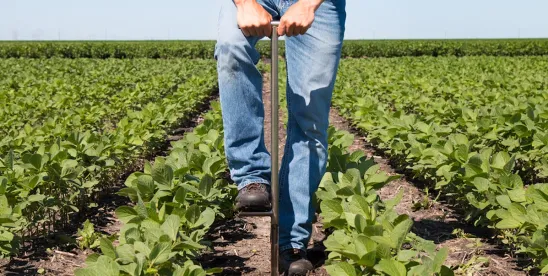The U.S. Department of Agriculture (USDA) has been around for more than 150 years, stressing the importance of American agriculture to a bountiful food production system since Abraham Lincoln first signed it into being in 1862. Lincoln himself, in fact, in his 1864 final annual message to Congress, christened USDA “the people’s Department,” just before commending it “to the continued attention and fostering care of Congress.” From industrialization to the mechanization of farming, through the post-industrial era and into the digital age, farmers are among the first to remind the rest of us of that universal truth: “we still gotta eat.”
Ensuring that capability has been among the most important missions of USDA, and recently that role has been tested by the new Administration’s emphasis on “controlling our borders” as a centerpiece issue for President Trump. In recent weeks, there have been mass deportation efforts specifically targeting geographic locations and industries identified as likely to house and employ significant numbers of undocumented immigrants. Among affected industries is farming, where up to 40 percent of those who work in food production occupations — as farmworkers or at food handling and processing facilities — are estimated to be undocumented.
Consequently, as the Administration’s deportation efforts ramped up in recent weeks, farm labor was reported to be impacted, either directly, with laborers being detained or arrested, or via rumors of enforcement sweeps keeping workers away from their jobs out of fear of the same. Then, to the surprise of many, in the last week, President Trump suggested that some undocumented workers have been here in the United States for years, working hard without incident, paying taxes, and breaking no laws — and should thus be allowed to stay, or at least not targeted for deportation as an enforcement priority.
The President specifically cited how the agricultural industry (along with the hospitality industry) was dependent on such labor and would otherwise suffer, with the resulting effects impacting the nation’s food supply. It was reported that U.S. Secretary of Agriculture Brooke Rollins was pivotal in conveying the concern of farmers and agricultural groups and emphasizing the need to have immigration enforcement policies that acknowledge and consider how important the undocumented workforce is to U.S. food production. And yet the suspension of worksite enforcement operations targeting farms, hotels, and restaurants was short-lived, with the Trump Administration apparently reinstating it again mere days later.
Meanwhile, the Administration’s “MAHA Report,” released on May 22, 2025, with Secretary Rollins as one of the Make America Healthy Again (MAHA) Commission members, essentially condemns the U.S. food supply as horrible and dangerous. The word “food” appears 260 times in the 68-page report, with repeated emphasis on the modern food production system resulting in ultra-processed food as it goes from farm to table with a stop in between for corporate players to foist dangerous methods of production, products, and the manipulation of consumer tastes upon it and us.
The MAHA Report frames the United States as a whole as “unhealthy,” with little, or at least too little, regulation by government agencies that have been “captured” and otherwise manipulated by corporate interests intent on defending and continuing a woeful status quo. The food industry generally, with farmers using conventional production methods (various crop inputs such as fertilizers and pesticides, sizable farming operations), is often referred to by critics as “Big Ag” — a reference to what many consider to be the scale and methods of production which characterize modern farming and food production. The MAHA Report, while citing the wonderfulness of farmers in their ability to be so productive, effectively holds the modern food production system, including farmers (or at least current farming methods), responsible for making America unhealthy.
On May 23, 2025, just one day after the MAHA Commission’s sweeping condemnation of modern food production practices, came Executive Order (EO) 14303: “Restoring Gold Standard Science.” Issued by President Trump, the EO declares that all federal agencies (USDA included) must base decisions on “the highest standards of scientific integrity.” That sounds good on paper, but it raised eyebrows in the Ag world. While the EO calls for transparency, peer-reviewed data, and decisions insulated from ideology, farm groups may be left wondering which science the Administration wants to elevate — because the science behind large-scale food production didn’t get much airtime in the MAHA Report.
Farm groups, anticipating what was to come in the MAHA Report, released a “Statement from Farmers of Major U.S. Agriculture Groups on Pending MAHA Report” two days before the Report itself was released:
The Make America Healthy Again Commission is expected to soon release a report that will have significant bearing on America’s farmers, producers and ranchers, and the public’s trust in our food system. In anticipation, the American Soybean Association, National Corn Growers Association, National Association of Wheat Growers, International Fresh Produce Association, and in turn, the farmers these groups represent, are imploring the administration to consider the consequences of this MAHA Commission report before it is finalized.
The statement goes on to add:
Despite the effort of many of our organizations to work with the MAHA Commission to provide factual information about American food production, we have heard disturbing accounts that the commission report may suggest U.S. farmers are harming Americans through their production practices and ‘creating foods that is [sic] destroying our microbiome and bodies—leading directly to our chronic disease crisis.’ Nothing could be further from the truth. Nutrition matters, health matters, and the confidence of consumers in the food supply matters tremendously.
Where is, or was, USDA?
This statement is but one of many alarms sounded by farm groups concerned about possible fallout from the work of the MAHA Commission. And the biggest fallout of all for those with a hand in American farming could be a new effort, endorsed by the Trump Administration, echoing the concerns of critics of Big Ag over the years. With criticism aimed at large acreage farms, large animal feedlots, a reliance on synthetic inputs, and the use of current food processing techniques and the argument being that the result of these things is dangerous (or at least unhealthy) food products being widely distributed in our homes, schools, and on grocery store shelves, there is more than enough fallout to go around.
With over 250 food and agricultural groups signing onto a June 17, 2025, letter to Secretary Rollins, U.S. Secretary of Health and Human Services Robert F. Kennedy Jr., and U.S. Environmental Protection Agency Administrator Lee Zeldin, urging that food and agriculture “have a seat at the table during the development of policy recommendations” related to the MAHA Report, it is now even clearer what farmers, and many agricultural stakeholders, think — that the MAHA Report is not scientifically supported (gold-standard or otherwise) and that it is in need of some serious revision. Putting aside the question of what role USDA played, or didn’t play, in the MAHA Report, will Secretary Rollins and staff be able to persuade the President that another initiative may need modification before its impact on farming could affect his standing in a rural America which up to now has been an anchor of support for his Administration?
With 42 out of 50 states — red and blue alike — directly represented in the letters’ signatories, as well as groups representing commodities as varied as pork and mint, hazelnuts and Christmas trees, and special interest groups as diverse as American Agri-Women and the National Black Growers Association, it seems that it is once again the farmers reminding us: we all still gotta eat.





 />i
/>i
